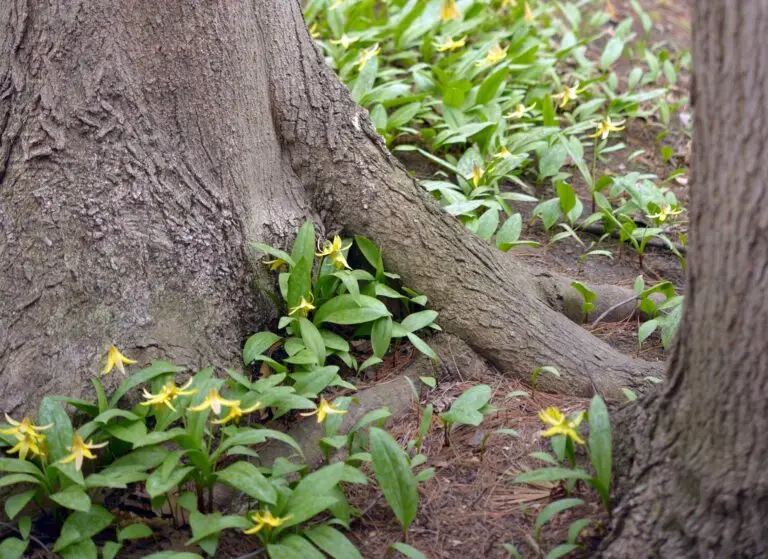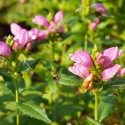You know it’s the spring on the East Coast when the Trout Lilies appear. Trout Lilies are known as ephemerals—a term given to wildflowers that appear for the brief period before the trees leaf out and block the sun from the forest floor below. We can use ephemerals in our own gardens as long as we plant them in areas that help mimic this environment. Trout Lilies are perfect replacements for non-native plants like crocus and daffodils—they bloom at the same time and give a similar pop of sunny color.

What are the benefits of planting Trout Lilies?
Looking for a native flower to replace non-native daffodils and crocuses? Trout Lilies are an excellent choice. These native ephemeral wildflowers bloom at the beginning of the spring with sculptural yellow flowers.
Native plants are plants that have grown in an area for thousands of years. Their DNA includes millennia of knowledge about the climate, soil, and wildlife in an area. This incredible knowledge of their home area gives three key benefits for gardeners:
- Native plants like Trout Lily are the most resilient choices for our gardens. They are the best choices to thrive with minimal care—especially compared to lawns or non-native plants.
- Once native plants are established, they are happy with just rain.
- Native plants offer the best food and habitat for wildlife (native bees depend on Trout Lilies for early spring pollen.)
- Native plants are gorgeous! Explore our native plant library to find other favorites.
Now that we’ve covered some of the benefits of Trout Lily, let’s dig into meeting this native gem.
New to native?
Before lawns and landscaping, native plants were here. They’ve fed birds, bees, and butterflies for thousands of years—and they’ll do the same in your yard. The best part? They’re easier to grow than you think.

How to grow Trout Lily
Planting native is easy if you mimic the plant’s nature home. For Trout Lilies, this means part sun in areas that are consistently moist, with soil that has lots of organic matter (think compost, or underneath trees.)
Trout Lily colonies can last for 200+ years
Although this flower is ephemeral and is only visible above ground for a month or so, these plants can live for a long time. Some Trout Lily colonies have lived for 200-300 years. (A plant that comes back year after year from the same root stock is called a perennial.)
Planting native plants that last for generations—also see Tulip Poplars and Celandine Poppies—ensures that what we do today will return positive benefits for millennia. It’s a humbling way to make gardening choices.
Where is Trout Lily native?
Trout Lily is native to half of North America, including most of the Canadian provinces. Any gardener from Nova Scotia to Louisiana can plant Trout Lilies.
FAQs
What are good places to plant Trout Lily?
In nature, Trout Lilies are found in forests filled with deciduous trees (or trees that lose their leaves in the fall.) They need these fallen leaves to give them the moisture and nutrients required to keep coming back year after year.
To mimic this environment in our gardens, plant Trout Lilies in areas near deciduous trees, add mulch to keep moisture levels consistent, and plant in areas that are shaded or partly shaded in the summer, when leaves come in.
Good places to plant Trout Lily include:
- Edges of borders
- Up against houses
- Walkways
- At the bottom of trees
How long does Trout Lily bloom?
Trout Lilies are short-lived ephemerals, completing their entire above-ground lifecycle within a month. Their bloom time is about two weeks.
If this seems short to you—remember that most daffodils and tulips bloom in our gardens for around the same length. (And if you’re interested in learning more about their growing cycle, Duke Farms has a good overview.)
Pair Trout Lilies with other native flowers that bloom afterward, all the way through to fall. (This ensures pollinators have lots to eat throughout the entire growing season.)
Where does the name Trout Lily come from?
This common name comes from their leaves. (Common names are the names given by the generations before.) Trout Lily’s leaves are beautifully speckled—reminding early European settlers of the sides of trout they found in North American streams.
It’s also known as…
It also has some other strange common names, including Dogtooth Violet, Yellow Adler’s Tongue, and Fawn Lily. (If you’d like to laugh at some other silly common names, read our Beautiful Native Plants with Terrible Names article.)
Where can I buy Trout Lily seeds or plants?
Buying or finding Trout Lily plants might take a little more time or energy than finding a more ubiquitous native flower like Purple Coneflower or Black-Eyed Susan. We’ve found a few online sellers to make it a little easier.
Trout Lily online plant and seed sellers
Here are some online seed sellers (alongside their locations) that sell Trout Lily seeds and/or plants:
- Mid-Atlantic Natives (Cobbs Creek, VA)
- Native Wildflower Nursery (Gruetli-Laager, Tennessee)
- Prairie Moon Nursery (Winona, Minnesota)
Plants and seeds grown close to home are tuned to your soil, weather, and pollinators. Stay within 500 miles—or about a day’s drive—to help your garden thrive naturally.
What are good pairings for Trout Lily?
Trout Lily is best paired with other flowers that will bloom throughout the rest of the spring and into the fall. Great examples of native plants to pair with Trout Lily include springtime flowers like False Blue Indigo, Celandine Poppy, wild irises, and Red Columbine, summer flowers like Alum Root, Cardinal Flower and Great Blue Lobelia, and fall flowers like native asters.
And now you’ve met the beautiful but short-lived Trout Lily! These are excellent native flowers to replace our obsession with non-native daffodils and crocuses. Once planted, Trout Lilies can spread over an area and come back year after year—thriving for 100+ years when happy. (No tulip or daffodil patch can match this longevity.) Although they appear and disappear within a month, their appearance is a happy reminder that spring is here. Head on over to our Beginner’s Guide to Native Lilies to meet other lilies from North America (including the jaw-dropping Turk’s Cap Lily.) Happy planting!
Sources
- USDA Plants Database, Trout Lily
- Duke Farms, Forgotten Flowers: Trout Lily, August 1, 2023
- Chesapeake Bay Program, Trout Lily
Other shade-loving natives
What if your feed was actually good for your mental health?
Give your algorithm a breath of fresh air and follow us.





















